NCERT Solutions for Class 11th Biology Chapter 7: Structural Organisation in Animals
Question 1: Answer in one word or one line.
(i) Give the common name of Periplaneta americana.
(ii) How many spermathecae are found in earthworm?
(iii) What is the position of ovaries in the cockroach?
(iv) How many segments are present in the abdomen of cockroach?
(v) Where do you find malphigian tubules?
Answer (i) The common name of Periplaneta americana is the American cockroach.
(ii) Four pairs of spermathecae are present in earthworms. They are located between sixth and the ninth segments. They help in receiving and storing the spermatozoa during copulation.
(iii) In a cockroach, the pair of ovaries is located between 12th and 13th abdominal segments.
(iv) In both sexes, the abdomen of a cockroach consists of ten segments.
(v) Malphigian tubules are main excretory organs of cockroaches. They form a part of the alimentary canal.
Question 2: Answer the following:
(i) What is the function of nephridia?
(ii) How many types of nephridia are found in earthworm based on their location?
Answer (i) Nephridia are segmentally arranged excretory organs present in earthworms.
(ii) On the basis of their location, three types of nephridia are found in earthworms. They are:
(a) Septal nephridia: These are present on both sides of the inter-segmental septa behind the 15th segment. They open into the intestines.
(b) Integumentary nephridia: These lie attached to the body wall from the third segment to the last segment, which opens on the body surface.
(c) Pharyngeal nephridia: These are present as three paired tufts in fourth, fifth, and sixth segments.
Question 3: Draw a labelled diagram of the reproductive organs of an earthworm.
Answer
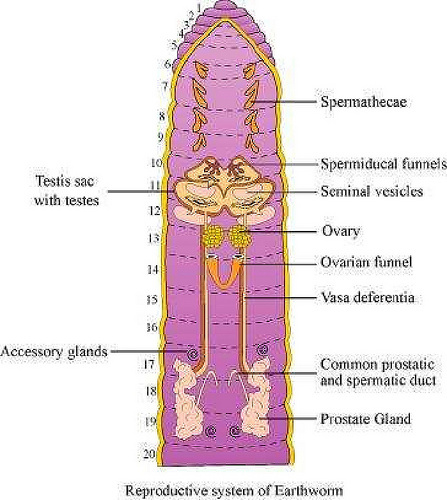
Question 4: Draw a labelled diagram of alimentary canal of a cockroach.
Answer
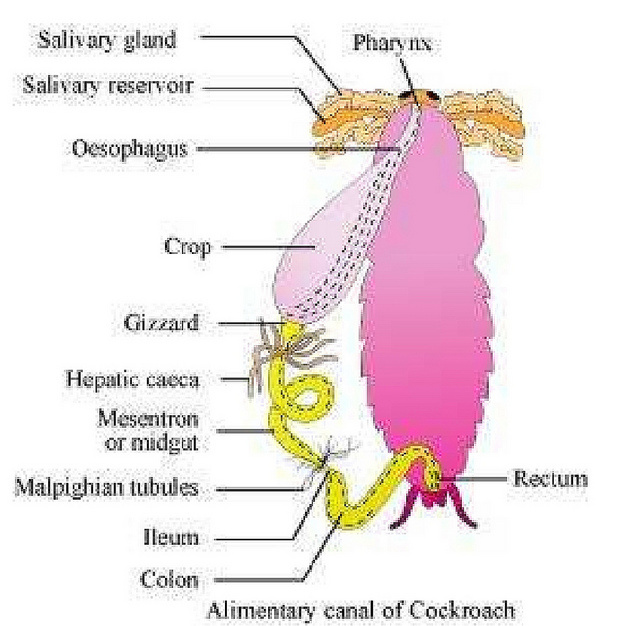
Question 5: Distinguish between the following
(a) Prostomium and peristomium
(b) Septal nephridium and pharyngeal nephridium
Answer (a)

(b)
![]()
![]()
Question 6: What are the cellular components of blood?
Answer Components of blood include erythrocytes (RBCs), leucocytes (WBCs), and thrombocytes (platelets). These components form 45% of blood. They are suspended in the remaining fluid portion, called plasma.
Mammalian erythrocytes are biconcave, coloured cells devoid of a nucleus. They help in transporting respiratory gases.
Leucocytes or white blood cells are nucleated cells. They can be divided into two types, granulocytes (neutrophils, eosinophils, and basophils) and agranulocytes (lymphocytes and monocytes). They help fight against various disease-causing germs entering the body.
Thrombocytes are cell fragments produced from megarkaryocytes of the bone. They play a major role during blood coagulation.
Question 7: What are the following and where do you find them in animal body
(a) Chondriocytes
(b) Axons
(c) Ciliated epithelium
Answer Chondriocytes:
They are cells of cartilages, and are present in small cavities within the matrix secreted by them.
Axons:
They are long, slender projections of neurons that help in carrying nerve impulses from the neuron body. Axons aggregate in bundles which make up the nerves. Ciliated epithelium:
It consists of simple columnar or cuboidal epithelium with cilia on their free surfaces. It is present on the inner surface of the oviducts and bronchioles. It helps in the movement of eggs or mucus in specific directions.
Question 8: Describe various types of epithelial tissues with the help of labelled diagrams.
Answer Epithelial tissue lines the surface of a body and forms a protective covering. Epithelium cells are packed tightly together with little intercellular matrix. Epithelial tissue in the body is of two types.
(a) Simple epithelium: It consists of a single layer of cells where cells are in direct contact with the basement membrane. It is further sub-divided into the following types:
(i) Simple squamous epithelium: It consists of a single layer of flat cells with irregular boundaries. It is found in the walls of the blood vessels and in the lining of alveoli.
(ii) Simple cuboidal epithelium: It consists of a single layer of cube-like cells. It is present in regions where secretion and absorption of substances takes place such as the proximal convoluted tubule region of the nephron.
(iii) Simple columnar epithelium: It consists of a single layer of tall, slender cells with their nuclei present at the base of the cells. They may bear micro-villi on the free surfaces. Columnar epithelium forms the lining of the stomach and intestines, and is involved in the function of secretion and absorption.
(iv) Ciliated epithelium: It consists of columnar or cuboidal cells with cilia on their free surfaces. They are present in bronchioles and oviducts from where they direct mucus and eggs in specific directions.
(v) Glandular epithelium:It consists of columnar or cuboidal cells involved in the secretion of substances. Glands are of two types, unicellular glands (goblet cells of the alimentary canal) and multicellular glands (salivary glands). They can be classified as exocrine (ductless glands) and endocrine glands (duct glands) by the method through which they release enzymes.
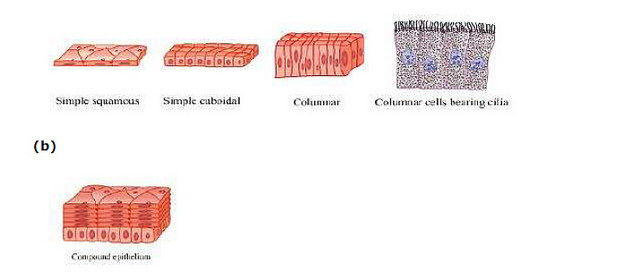
Compound epithelium: It consists of many layers of cells. It is involved mainly in the function of providing protection and has a limited role in secretion and absorption. Examples of compound epithelium include the dry surface of the skin or moist inner lining of the buccal cavity, pharynx, pancreatic ducts, and the inner lining of ducts of salivary glands.
Question 9: Distinguish between
(a) Simple epithelium and compound epithelium.
(b) Cardiac muscle and striated muscle
(c) Dense regular and dense irregular connective tissues
(d) Adipose and blood tissue
(e) Simple gland and compound gland
Answer

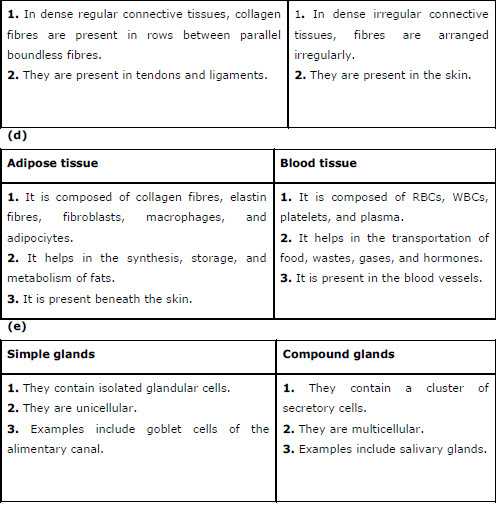
Question 10: Mark the odd one in each series:
(a) Areolar tissue; blood; neuron; tendon
(b) RBC; WBC; platelets; cartilage
(c) Exocrine; endocrine; salivary gland; ligament
(d) Maxilla; mandible; labrum; athorax; coxa
Answer (a) Areolar tissue, blood, and tendons are examples of connective tissues. Neuron is an example of neural tissue.
(b) RBCs, WBCs, and platelets are the three most important components of blood. Cartilage is therefore, the odd one out.
(c) Exocrine, endocrine, and salivary glands are examples of simple glandular epithelium. Ligament is a connective tissue.
(d) Maxilla, mandible, and labrum are mouthparts of a cockroach. Antennae, on the other hand, are present in the head region of cockroaches.
(e) Protonema forms the developmental stage in the life cycle of a moss. Mesothorax, metathorax, and coxa are parts or segments present in the legs of a cockroach.
Question 11: Match the terms in column I with those in column II:
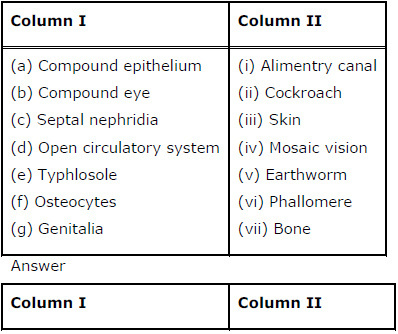

Question 12: Mention briefly about the circulatory system of earthworm
Answer Earthworms (Pheretima) have closed blood vascular systems, which consists of the heart, blood vessels, and capillaries. The heart pumps blood for circulating it in one direction. Blood is supplied by smaller blood cells to the gut nerve cord and the body wall. Blood glands are present in the 4th, 5th, and 6th segments, which produce blood cells and haemoglobin dissolved in blood plasma. Blood cells in earthworms are phagocytic in nature.
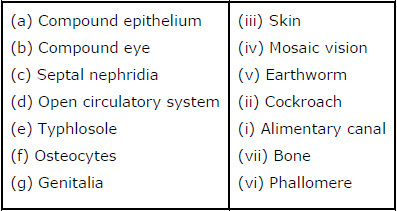
Question 14: Mention the function of the following
(a) Ureters in frog
(b) Malpighian tubules
(c) Body wall in earthworm
Answer (a) Ureters in frogs: A ureter acts as a urinogenital duct, which carries sperms along with urine in male frogs.
(b) Malphigian tubules: Malphigian tubules are excretory organs in cockroaches.
(c) Body wall in earthworms: In earthworms, the body wall consists of muscle layers. It helps in movement and burrowing.
Go Back to NCERT Solutions Biology Page Physics Chemistry Maths
To start your test
register with us:
To start
your test, registered user must login with their User Name & Password: